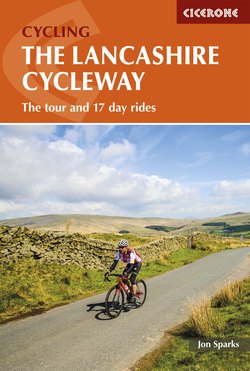Читать книгу The Lancashire Cycleway - Jon Sparks - Страница 10
На сайте Литреса книга снята с продажи.
ОглавлениеTHE NORTHERN LOOP
208.5km/130 miles
Loyn Bridge (Stage 1)
INTRODUCTION
The Northern Loop embodies everything that’s great about cycling in Lancashire. As a Tour de France stage it would be considered a moderate test, neither very long nor very mountainous, and would be knocked off in under six hours. However, if you would rather take six days over it, you will see more – a great deal more – and probably experience less pain and much more pleasure as a result.
As with any circular route, the first question is where to start. You might settle this by considering whether you would rather get the hilly part out of the way early on, or ease yourself in on the flatter stuff. However, if you are arriving by train, Lancaster is the logical starting place and gives you a fairly gentle introduction, then the major climbs, and finally a long, mostly easy winding-down. It’s also historically appropriate, Lancaster being the traditional county town.
The Lancaster Link, following an old railway line out of the city alongside the River Lune, is a painless opening. You meet the official Cycleway route as you cross the river into Halton, the first of many attractive villages along the way. A short climb lifts you onto a ridge which gives prospects of things to come. You descend to Carnforth, then enter the Arnside and Silverdale Area of Outstanding Natural Beauty, the name nearly as long as the area itself: this is the second-smallest mainland AONB.
Intricate and genuinely pretty, it may be small, but clichés about quarts and pint pots are almost irresistible. The often-leafy lanes twist and wriggle, and it would be easy to take a wrong turning, except that there are no wrong turnings here. However, if you follow the route as described, you’ll get only the merest glimpse of the coast. It could be worth taking the short extra loop to Arnside (in Cumbria), which has a Youth Hostel as well as a great outlook over the Kent estuary.
The main route flirts with the Cumbrian border as it leaves the AONB, then crosses a corridor of flat country through which run the West Coast Main Line, Lancaster Canal and the M6. A quiet, undulating interlude charms its way across to the Lune Valley. There’s a tucked-away feel to this patch of country, and some of the most traffic-free riding anywhere on the Cycleway.
As you sweep down into the Lune Valley, the great ridge of the Bowland Fells looms ahead. The climb begins soon after crossing the river, ascending by stages from wooded valleys, through more open pastures and out onto the wide moors.
A long steady climb, which gets steeper just when you least want it to, Cross O’Greet is mean, moody – and magnificent. Not just for the views, either, sensational though they are. The climb itself – the actual business of getting up it on a bike – is genuinely challenging, perhaps all-consuming. But if you pace yourself, and your bike has the right gears, you can do it. And those views are infinitely better because you’ve got there by your own efforts.
Then there’s the descent. Cooled yet elated, you swoop down into the warm little village of Slaidburn. Few things will ever taste better than that first pint at the Hark to Bounty or mug of tea at the café by the bridge.
From Slaidburn there’s a bit more climbing, a mere bagatelle after Cross O’Greet, and then a grand section over a rumpled upland before you drop into the Ribble Valley. The local tourist office is fond of repeating that the Queen once said she’d like to retire to this area. One can see why: it encompasses a lot of proper English countryside, with small fields, hedgerows and a richness of trees, bounded by skylines of rock, peat, sedge and heather. Pretty villages – most of them not at all self-conscious about their prettiness – crop up at regular intervals.
At the heart of the valley is Clitheroe, one of the nicest small towns in England, clustered round a castle that surely never intimidated anyone. If Castle Street were traffic-free, Clitheroe would be just about perfect. As it is, maybe it’s a good thing that the Cycleway sidles past just to the north. Then there’s Whalley, with its serene Abbey ruins, and Ribchester, another handsome village and a significant Roman site.
In many other counties the next stage, looping at a discreet distance around Preston, would score pretty highly. By Lancashire standards it is merely pleasant. West of the main road and railway lines the undulations flatten out, the fields grow larger, and then reclaimed mosslands begin to reach to the horizon. On Rawcliffe and Pilling Mosses there’s a dead flat, almost dead straight, run of 5km. It doesn’t sound much, but compared to the ever-changing prospects more normal in Lancashire it seems almost endless.
If the wind is favourable (and it usually is) there’s a fast run to Cockerham, where hills begin again. Gentle at first, the slopes get a little grander as the route hems the skirts of the Bowland Fells, through the Quernmore valley just east of Lancaster. Crook O’Lune is a lovely spot, and you may want to loiter a little. The fun’s almost over, just that last, imperceptibly downhill ride back into Lancaster and the train.
Grim up North? You must be kidding.
